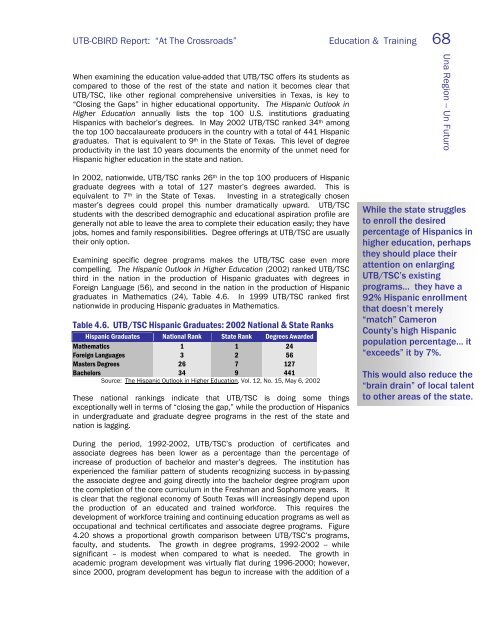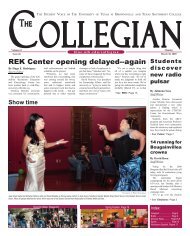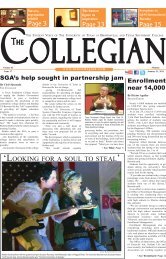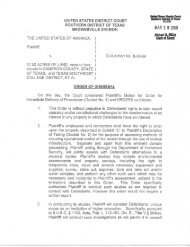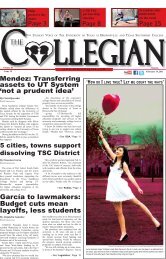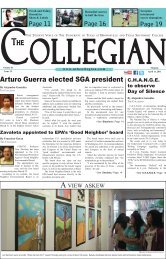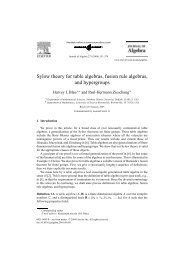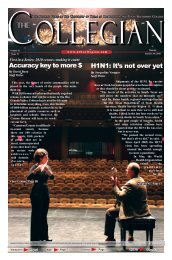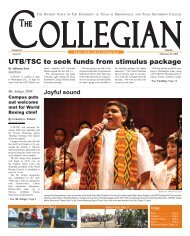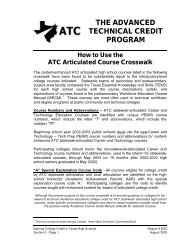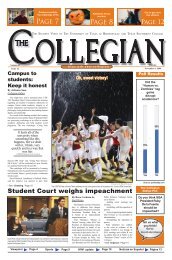cameron county/matamoros - blue - The University of Texas at ...
cameron county/matamoros - blue - The University of Texas at ...
cameron county/matamoros - blue - The University of Texas at ...
You also want an ePaper? Increase the reach of your titles
YUMPU automatically turns print PDFs into web optimized ePapers that Google loves.
UTB-CBIRD Report: “At <strong>The</strong> Crossroads” Educ<strong>at</strong>ion & Training 68<br />
When examining the educ<strong>at</strong>ion value-added th<strong>at</strong> UTB/TSC <strong>of</strong>fers its students as<br />
compared to those <strong>of</strong> the rest <strong>of</strong> the st<strong>at</strong>e and n<strong>at</strong>ion it becomes clear th<strong>at</strong><br />
UTB/TSC, like other regional comprehensive universities in <strong>Texas</strong>, is key to<br />
“Closing the Gaps” in higher educ<strong>at</strong>ional opportunity. <strong>The</strong> Hispanic Outlook in<br />
Higher Educ<strong>at</strong>ion annually lists the top 100 U.S. institutions gradu<strong>at</strong>ing<br />
Hispanics with bachelor’s degrees. In May 2002 UTB/TSC ranked 34 th among<br />
the top 100 baccalaure<strong>at</strong>e producers in the country with a total <strong>of</strong> 441 Hispanic<br />
gradu<strong>at</strong>es. Th<strong>at</strong> is equivalent to 9 th in the St<strong>at</strong>e <strong>of</strong> <strong>Texas</strong>. This level <strong>of</strong> degree<br />
productivity in the last 10 years documents the enormity <strong>of</strong> the unmet need for<br />
Hispanic higher educ<strong>at</strong>ion in the st<strong>at</strong>e and n<strong>at</strong>ion.<br />
In 2002, n<strong>at</strong>ionwide, UTB/TSC ranks 26 th in the top 100 producers <strong>of</strong> Hispanic<br />
gradu<strong>at</strong>e degrees with a total <strong>of</strong> 127 master’s degrees awarded. This is<br />
equivalent to 7 th in the St<strong>at</strong>e <strong>of</strong> <strong>Texas</strong>. Investing in a str<strong>at</strong>egically chosen<br />
master’s degrees could propel this number dram<strong>at</strong>ically upward. UTB/TSC<br />
students with the described demographic and educ<strong>at</strong>ional aspir<strong>at</strong>ion pr<strong>of</strong>ile are<br />
generally not able to leave the area to complete their educ<strong>at</strong>ion easily; they have<br />
jobs, homes and family responsibilities. Degree <strong>of</strong>ferings <strong>at</strong> UTB/TSC are usually<br />
their only option.<br />
Examining specific degree programs makes the UTB/TSC case even more<br />
compelling. <strong>The</strong> Hispanic Outlook in Higher Educ<strong>at</strong>ion (2002) ranked UTB/TSC<br />
third in the n<strong>at</strong>ion in the production <strong>of</strong> Hispanic gradu<strong>at</strong>es with degrees in<br />
Foreign Language (56), and second in the n<strong>at</strong>ion in the production <strong>of</strong> Hispanic<br />
gradu<strong>at</strong>es in M<strong>at</strong>hem<strong>at</strong>ics (24), Table 4.6. In 1999 UTB/TSC ranked first<br />
n<strong>at</strong>ionwide in producing Hispanic gradu<strong>at</strong>es in M<strong>at</strong>hem<strong>at</strong>ics.<br />
Table 4.6. UTB/TSC Hispanic Gradu<strong>at</strong>es: 2002 N<strong>at</strong>ional & St<strong>at</strong>e Ranks<br />
Hispanic Gradu<strong>at</strong>es N<strong>at</strong>ional Rank St<strong>at</strong>e Rank Degrees Awarded<br />
M<strong>at</strong>hem<strong>at</strong>ics 1 1 24<br />
Foreign Languages 3 2 56<br />
Masters Degrees 26 7 127<br />
Bachelors 34 9 441<br />
Source: <strong>The</strong> Hispanic Outlook in Higher Educ<strong>at</strong>ion, Vol. 12, No. 15, May 6, 2002<br />
<strong>The</strong>se n<strong>at</strong>ional rankings indic<strong>at</strong>e th<strong>at</strong> UTB/TSC is doing some things<br />
exceptionally well in terms <strong>of</strong> “closing the gap,” while the production <strong>of</strong> Hispanics<br />
in undergradu<strong>at</strong>e and gradu<strong>at</strong>e degree programs in the rest <strong>of</strong> the st<strong>at</strong>e and<br />
n<strong>at</strong>ion is lagging.<br />
During the period, 1992-2002, UTB/TSC’s production <strong>of</strong> certific<strong>at</strong>es and<br />
associ<strong>at</strong>e degrees has been lower as a percentage than the percentage <strong>of</strong><br />
increase <strong>of</strong> production <strong>of</strong> bachelor and master’s degrees. <strong>The</strong> institution has<br />
experienced the familiar p<strong>at</strong>tern <strong>of</strong> students recognizing success in by-passing<br />
the associ<strong>at</strong>e degree and going directly into the bachelor degree program upon<br />
the completion <strong>of</strong> the core curriculum in the Freshman and Sophomore years. It<br />
is clear th<strong>at</strong> the regional economy <strong>of</strong> South <strong>Texas</strong> will increasingly depend upon<br />
the production <strong>of</strong> an educ<strong>at</strong>ed and trained workforce. This requires the<br />
development <strong>of</strong> workforce training and continuing educ<strong>at</strong>ion programs as well as<br />
occup<strong>at</strong>ional and technical certific<strong>at</strong>es and associ<strong>at</strong>e degree programs. Figure<br />
4.20 shows a proportional growth comparison between UTB/TSC’s programs,<br />
faculty, and students. <strong>The</strong> growth in degree programs, 1992-2002 -- while<br />
significant – is modest when compared to wh<strong>at</strong> is needed. <strong>The</strong> growth in<br />
academic program development was virtually fl<strong>at</strong> during 1996-2000; however,<br />
since 2000, program development has begun to increase with the addition <strong>of</strong> a<br />
Una Region -- Un Futuro<br />
While the st<strong>at</strong>e struggles<br />
to enroll the desired<br />
percentage <strong>of</strong> Hispanics in<br />
higher educ<strong>at</strong>ion, perhaps<br />
they should place their<br />
<strong>at</strong>tention on enlarging<br />
UTB/TSC’s existing<br />
programs… they have a<br />
92% Hispanic enrollment<br />
th<strong>at</strong> doesn’t merely<br />
“m<strong>at</strong>ch” Cameron<br />
County’s high Hispanic<br />
popul<strong>at</strong>ion percentage… it<br />
“exceeds” it by 7%.<br />
This would also reduce the<br />
“brain drain” <strong>of</strong> local talent<br />
to other areas <strong>of</strong> the st<strong>at</strong>e.


